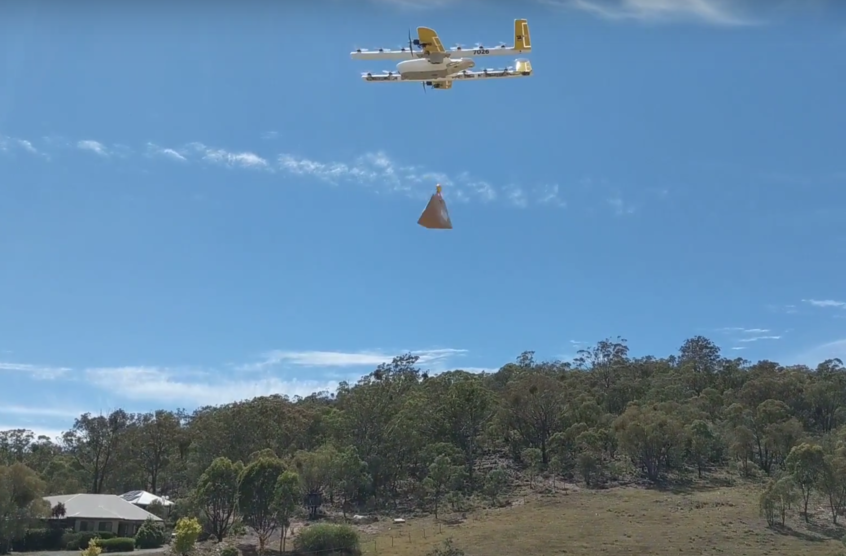In the second week of a steaming August summer, something quite amazing happened, something that has been called the first of its kind…ice cream was delivered to a young boy, but the amazing part is not what was delivered but how it was delivered. In a suburban county in Virginia, Project Wing completed the first long-distance, residential drone delivery in the United States. Some say this is the inevitable future, one that may not be as distant as it seems, where the sight of drones whipping and flying around in the sky making deliveries is as normal as the mail-carrier delivering the mail. No more pizza guy, no more Uber Eats, instead pull out a smart phone, place a sushi order from the place a few miles down the road and in a matter of minutes the hum of spinning blades can be heard as a drone hovers into view lowering its package smoothly and precisely into your hands.
Virginia is one of 10 states that had specific counties selected within their borders to be test grounds for drone delivery. In order to allow this a number of technological obstacles and regulations were lowered in these areas only so that the trial run could take place. However, the very sci-fi-like future of regular drone delivery is still more than a few years away, in terms of it becoming as easy and as automated as ‘1, 2, 3’ but at the same time it is ultimately only a matter of time before this vision becomes a reality, according to most experts the only debate is how long?
A technology like this that creates such a situation where the end game is inevitable but the only unknown is how long until it is reached, creates a very unique business situation and basically ‘the race is on’ as major tech players around the world along with big time investors are all gearing up their ‘horse’ to win the ‘race’ no matter how far away the finish line may be. But it is safe to say that not only has this high tech, money plump race begun, it is well under way.
JD.com - Leading the pack
Of the many contestants in the race, the early leader is believed to be JD.com, China’s e-commerce mega player who apparently already has a massive fleet of delivery drones ready in existence with plans in motion to build thousands more. They also have a variety of different types of drones with different attributes, even some that are said to be able to carry up to 1 ton. The main issue now appears to be battery life but again tech experts are confident that it will be solved eventually, again in only a matter of time, the looming sense of inevitability is a repeating theme amongst the drone delivery field. China also has a unique situation because although their large population massively utilizes and benefits from e-commerce there may even be an equal amount of people in remote and undeveloped areas of China that get none of this because of their locations or lack of technology. Drones would change all this and bring these people into reach and bold estimations are being speculated upon that drone delivery could double China’s already more-than-booming e-commerce economy.
This is where drone delivery would be used: in large, urban or farm country, in remote locations, or in underdeveloped areas. In densely populated urban areas it could be more work then it would be worth with all the obstacles, tight spaces, and relatively short distances. Now, that is not to say that drones will still not be used in cities. For construction, real estate, insurance, energy, any many other fields drones will still be highly useful no matter the location.
Amazon, Google, and Boeing
American giant Amazon is not going to be far behind in any tech race and they are working on developing a fleet of drones and a fast delivery service utilizing drones to make deliveries in 30 minutes or less. Amazon has also recently been granted a patent for drone software that can react to certain human gestures. Amazon is however considered to be a few years behind JD.com in terms of development and execution, but whatever the future of drone delivery brings, you can be certain that Amazon will be a major player. The same can also be said for giant Google, who is certainly going to have a major role in this rising industry. Google is working with their parent company, Alphabet to develop a drone delivery system entitled, ‘Project Wing’ and exciting developments are a regular thing with Google as everyone knows by now.
A large company getting in early on the action is Boeing which has invested millions in drones and drone delivery technology working with the company Matternet, they have already begun successful drone delivery programs in Switzerland for example where the focus has been on the Healthcare Industry.
What's the holdup?
Drone delivery is being calculated to cut costs as much as 50-70 percent which is clearly great all around, but the questions that must be asked is with all this great cost cutting, how many jobs will also be cut or lost? How many delivery workers, mail carriers, UPS/FedEx workers, and truck drivers will be put out of work by drones? Those favoring drone delivery argue that it will replace many jobs, but that it will also create an equal amount of jobs such as Drone Technicians, Drone Pilots, a plethora of jobs in the software industry as well as factory jobs. But the answer remains to be seen and there are those who stand nervous among the enthused.
It is hard to argue against how drone delivery is being used in underdeveloped and war-torn countries, where life saving supplies and medicine simply cannot be delivered because often times the location is in such a remote place that no plane or vehicle can get there or maybe even if they can get there, the location doesn’t possess the infrastructure for a plane to land or there are no proper roads for a vehicle as is the case in Rwanda where drones are delivering medicine that is literally saving lives and without drones it would most likely be months if ever before something can be delivered to such distant and remote locations. Or in countries such as Iran where fighting is rampant and prevents deliveries of any kind out of fear of an attack, drones are able to deliver medicine and small amounts of vital supplies to the innocent who suffer amidst war torn countries. There is no denying the power to bring good and help to the world that this technology allows.
Another major factor that will play a role in forming how drone delivery develops and that is the necessary development and advancement of secure software and security programs aimed at preventing hacks of any kind. Because one thing that is inevitable is that as the drone delivery industry grows, so too will the number of criminals and hackers trying to chip away and interrupt this new advancement. One major roadblock would certainly be if that sushi delivery mentioned earlier turned into a kamikaze style drone flight that could easily end in serious injury or damage. So clearly, as drone delivery technology grows so too will cyber security need to continue to develop.
As the race progresses and the excitement builds it becomes less of a race to win and more of a joining of the race just to simply, “not be the one left out” as is the greatest fear of any trendy tech company, of any company really, so now the drone market is getting saturated and flooded with small startup companies and big mega corporations alike all desperately seeking to not be left out or to fall too far behind the perpetual 8-ball. And to think that this great tech race, one that supposedly will change our world, began with with a simple delivery of ice cream to a child. Maybe one day hundreds of years from now people will look back at that kid and his ice cream as a monumental moment in history or maybe not, maybe it will just be a kid and ice cream, but as the cliché goes…only the inevitability of time will tell.


